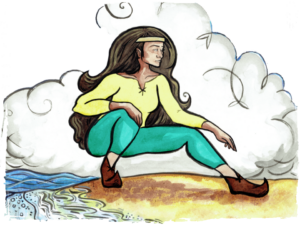
Five stories that changed the Irish world
The following stories -and their accompanying images- tell some of the stories of the first peoples in Ireland; of the gods that once resided there and what happened to them.
It is interesting to consider how they continue to coexist with modern ways of life in Ireland today.
Folklore has long been a mainstay of Irish heritage and culture. Influencing music and literature; verse, song and language, the Celtic traditions of Paganism and myth percolate through the ages. Gael Linn, An tUltach and the Liverpool Irish Festival teamed up to create an artist commission to help explore some of Ireland’s stories.
The winner of the commission was Nuala Monaghan (nualamon.com), an artist, illustrator and tour guide at Navan Fort (Armagh, Northern Ireland). Having pitched to contextualise the ‘life of the Iron Age Celt’ and bring ‘gods and goddesses to life’, her work was selected.
What you see in this brochure (click here to download), and in the exhibition around the Calder Stones, is all Nuala’s work; in which she retells these classic Irish folk stories.
- Ceasair
- The Tuath De Danann: Gods who roamed this land
- Warriors and Souls
- The Sons of Mil
- The Tuath De Danann: now fairies.
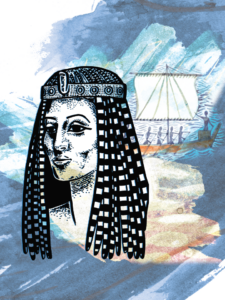 Ceasair: the first person in Ireland
Ceasair: the first person in Ireland
We all dream of a place like no other, but -for all the dreaming it is possible for a mere mortal to do- the land the gods whispered of into Ceasair’s mind was unimaginable. Though she was unable to envision it fully, she trusted them unquestioningly, with all of her mind, body and soul.
Ceasair’s father -Bith- came to her, seeking refuge. He told her that her grandfather Noah (who professed his faith to a single god, as doc-umented in the Old Testament) had visions of his powerful god’s plan revealed to him, which would send a flood so great it would drown all lands and everyone who inhabited them. This was to get rid of the evil in the world. Ceasair’s gods told her that the land they whispered of to her, known as ‘Inis Fáil’ (the Land of Destiny), had never been touched by human flesh therefore no evil existed there. Thus, it would be safe from the flood of Noah’s god.
Bith -along with his son Ladra and friend Fintan MacBochra- wanted to join Noah on his voyage in the grand ark he was building. Noah was not fond of his son so refused them entry.
When they approached Ceasair with the dilemma, she told them of Inis Fáil, the undisturbed Land of Destiny, which she intended to sail to. She would happily accommodate them on the condition that they swore allegiance to her. She recruited 150 women, each equipped with knowledge and skills that would be needed in this adventure; had three boats built and brought some sheep, for good measure.
After years of travelling, seeing other lands and learning of other cultures along the way, only one boat survived the whole journey to Ireland.
Fifty women and the three men were on board. Ceasair, being their leader, was the first to disembark, and so was the first person in the all of this world and the Otherworld to touch Ireland.
Fintan, now Ceasair’s lover, was the second to land and so he became the first man.
Soon after, the others clambered down onto the land. They divided themselves into three groups with a man each to populate it; Fintan and Ladra each took 17 women, whilst Bith took 16 (as he was getting on in years).
For a time, they lived happily, but before long the hefty task overwhelmed Bith. His heart failed him and he became the first man to die in Ireland. Ladra took on Bith’s portion of work,
but had been weakened by a wound when he first landed on the island, so the job soon became too taxing for him and he, too, died.
Ceasair was not pleased at the idea of sharing her beloved Fintan with so many women.
She was irreversibly heart-broken at his decision to flee and transform himself into a salmon in order to hide away from the crowd. Unable to live with the grief, she died.
After all of the trials and tribulations the people of Ceasair had gone through, and the wonderful experience they had in travelling and finally finding Inis Fáil, they found themselves without their most important leader.
One-by-one the population dwindled, until finally, only Banba, the warrior and patron goddess of Ireland, was left. Fintan turned back to human form again -for a time- and joined her. It is said that the Fomorians -a later tribe- descended from this couple.
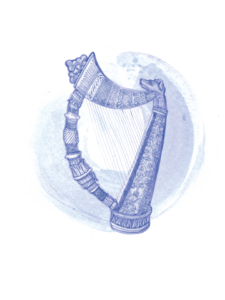 The Tuath De Danann: Gods who Roamed this Land
The Tuath De Danann: Gods who Roamed this Land
The Tuath De Danann were the descendants of a much earlier tribe in Ireland, the Nemedians, who were defeated by the Fomorians and scattered all over, many, many years ago.
They travelled all around the known world, gathering knowledge and skill that might set them apart from other peoples. They followed the Goddess Danu, and so -when they first came
to Ireland- they were simply known as the “God People”.
On their travels, they gathered four magical treasures which came from four mythical cities in the North; Falias, Gorias, Finias, and Murias.
The first treasure was the Lia Fáil, or Stone of Destiny, which to this day lies at the top of the Hill of Tara.
It is said to roar when the rightful heir to the throne sits upon it.
The second was the Claíomh Solais, or Sword of Destiny, which never missed its target.
The third was the Cauldron of the Dagda, which never ran dry or left anyone dissatisfied.
And finally, the fourth was the Sleá Bua, the powerful and unstoppable spear of Lugh.
The Dagda, father of the Tuath De Danann, also had another great treasure of his own; a magical harp, which only he could play and would move any listener however he so chose.
When it came to times of need, the Dagda could help his people using his music to give them the courage needed to go into battle; provide restful sleep for weary warriors or offer relief from mourning; he could ease the ebbs and flows of life for his people at this war-torn time.
When the Tuath De Danann arrived in Ireland, a tribe- called the Fir Bolg- resided there. The Fomorians (being raiders) still came and went as they pleased, with their stronghold at Tory Island, off the coast of Donegal. The Tuath De Danann cast a magical mist over the West coast of Connaught, that they could land without being disturbed.
When the fog cleared, the Fir Bolg saw that camps had been built and there was a new tribe among them.
At first, they were not threatened by each other. They exchanged weapons, learning from one another and seeing their differences in craft and skill, until the Fir Bolg decided they would not share this land. So followed the first Battle of Moytura, in which the Tuath came out victorious.
Or so it seemed at the time. Nuada -the King of the Tuath De Danann- lost his arm in the fight. According to their laws he could no longer remain king, as ‘a person who was not whole’ could not lead their army.
They chose Bres the Beautiful to rule them, soon learning that he was not a good fit for the job.
Bres was half Fomorian himself, so when the raiders came and imposed taxes upon his people, he turned a blind eye, all the while imposing steep charges upon them himself.
Lugh, a god of many talents (and also half Fomorian), rallied the half-starved tribe together.
He led them into the second battle of Moytura, against Bres and his tyrannical allies. Lugh -today recognised as a god of Sun and War- fulfilled the prophecy, which dictated that the Fomorian leader, Balor of the Evil Eye, would only be slain by his own grandson.
The Tuath De Danann were again victorious and restored Nuada to the throne, by calling their healer -Dian Cecht- to create a silver hand for him that he might be whole again and fit for kingship. The People of the Goddess Danu found themselves reigning happily in Ireland for many years after.
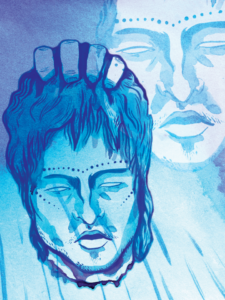 Warriors and Souls
Warriors and Souls
For many years after the arrival of the Tuath De Danann, warriors modelled themselves on these powerful gods. So what were they like?
Ulster was the only province with its own fully trained army, known as the Knights of the Red Branch.
There, every child was taught to play with the hurl, which would use the same muscles and movement needed for sword fighting; indicating who had the flare and skill required to become a warrior. Both men and women were able to join, but it was not for the faint-hearted.
Battles very often consisted of one-on-one combat, with warriors being nominated to fight an enemy’s chosen champion. Warriors only fought to the death if it was absolutely necessary.
The typical Iron Age Celt (c.1200BCE) was not afraid of death; their faith in immortality (eternal life) was unshakeable. Celts believed the soul went to the Otherworld after death, so a person may have the chance to come back and live in this world again.
They also believed that the soul was contained in the head, therefore it was sensible to come home from battle with enemies’ heads, lest they seek revenge in the next life. Severed heads were placed on spikes outside dwellings, by doorways and buried under entrances. This would ward off evil spirits. Such heads were even said to whisper prophesies (fortunes).
As incredulous (doubtful) as this tradition may seem, it is still to be seen today reflected in our Hallowe’en tradition of carving faces in to pumpkins and placing them in windows and doors!
Warriors did not wear armour; in fact, they didn’t wear anything when going into a fight! This was beneficial for two reasons; a superficial cut might not kill a person, but bacteria on fibres of clothing could, so the threat of infection was greatly reduced.
It also showed the opponent you had nothing to hide; weapons could not be concealed, demonstrating it would be a fair fight.
Blue war paint -made from the woad plant- was used to adorn bodies in swirls. This indicated which clan a fighter was from. This meant it was easy for those on the battlefield to distinguish friend from foe, and the frenzy could rampage on. Woad, coming from the same family as cabbage, has cooling properties, which meant the war paint could soothe wounds, too.
With life expectancy being between thirty and forty years, it was not common for a person to become bald of natural causes. However, warriors used a special paste on their hair, which made it bleached and brittle. Consequently, a bald person would be well respected, as it would be assumed they were an excellent fighter, who had seen many battles.
The paste was made of stale urine and ground limestone and spiked into the air like lightning bolts; a tribute to the god of the sun and war; Lugh.
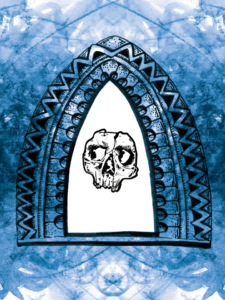 The Sons of Mil
The Sons of Mil
Along the North coast of Spain, a rich old man, Ith, looked out of the window of his tallest tower and -straining his eyes- thought he could see a land*. His servants and family could not see what he was looking for, but he determinedly told them that there was a land covered in forest and beautiful landscapes out there.
* A Coruña on the north Spanish coast is 590 miles from Cork, Ireland.
What Ith did not know was that the land he was looking at was Ireland. Up until this time, the Tuath De Danann ruled and lived harmoniously there. That was until the High King died at the Hill of Tara. His three sons, Mac Cuill, Mac Cecht and Mac Gréine, could not agree amongst themselves how to divide the land between them. The Tuath De Danann were on the brink of war.
It wasn’t long before Ith decided to gather men together to sail to this land. When they arrived, it was everything Ith dreamed of and more.
He marvelled at the land and -when he eventually came to the Hill of Tara- he was welcomed as a visitor.
He soon found himself before the quarrelling brothers: Mac Cuill, Mac Cecht and Mac Gréine. Upon meeting this prosperous old man -a man who had much more life experience than themselves- they decided it would be wise to ask him for advice on their disagreements.
Taken aback, Ith was happy to share his thoughts on the matter. Wasn’t it best to follow the laws and customs
of the land? This island which flourished for years under the rule of the Tuath De Danann? Was there a reason why it couldn’t continue to do so? It was the perfect country, he said, never too hot or cold, abundant in all the resources any human could need or want and the most beautiful place he’d ever seen.
The brothers conferred. All they could gather from Ith’s advice was that he looked upon the land with too much adoration; why would anyone speak so plainly about their love for something, unless they planned to take it for themselves? And so, without hesitation, the brothers took the life of the old man. Having done so, they returned to their stalemate; again on the brink of war with no one brother prepared to start it.
Ith’s men returned to Spain and brought news of the fate of Ith to his grandson, Mil, who was outraged. Mil gathered his men and set out to seek vengeance immediately. On their voyage, Mil himself died, but his sons, Amergin, Eremon and Eber Donn, were well equipped and ready to fight for their cause.
The Sons of Mil made their way to the Hill of Tara and confronted the three brothers of the Tuath De Danann.
The three kings requested three days to prepare for battle. They asked for the Sons of Mil to return to their boats and stay nine waves away from the coast in waiting, so that neither would have the upper hand. Amergin, being the wisest, agreed to this condition and happily retreated.
However, the Tuath De Danann had no intention of playing fairly. They set their druids to send a storm to scatter the ships so that they would lose each other and be unable to land.
Amergin sent one of his men to look out over the fog on the crow’s nest to see where the storm was coming from,
but the man fell to his death. As he fell, he shouted to Amergin “no storm. All calm”. This confirmed Amergin’s fears that it was not a natural, but a magical mist, sent by their opponents to confound them.
A powerful man himself, Amergin used his own magic to still the clouds and clear the skies. The Sons of Mil were furious and were no longer prepared to play by the rules of the Tuath De Danann. They prepared to come on shore.
Learning of their imminent arrival, the Tuath De Danann sent another storm forcing the Sons of Mil to travel around Ireland, eventually sailing up the River Boyne. Nearing the Plain of Tailtiu -where battle would commence- the Sons of Mil passed three queens of the Tuath De Danann, Banba, Fodla and Eriu. They promised to help the Sons of Mil, provided they would name the land after them. For a long time, Ireland did have these three names.
The Tuath De Danann’s dishonourable behaviour fuelled the Sons of Mil on the battlefield, who showed no mercy as they slaughtered the three brothers. Knowing the end was near, the Tuath De Danann retreated. Some say,
the Tuath De Danann -a proud race- fled from the Sons of Mil unwilling to live under the rule of another people. They hid, with their magic, in the hills and rivers. Some say that -knowing they were fighting a losing battle- the Tuath De Danann called for a truce in which the Sons of Mil agreed to share the land, half and half with the Tuath De Danann; the upper half for themselves, and the lower for the gods that had fallen from grace, only to be recognised as fairies ever after.
Or, perhaps, the Tuath De Danann had won after all. Although they are underground, they are still with us to this day, and the Sons of Mil are not.
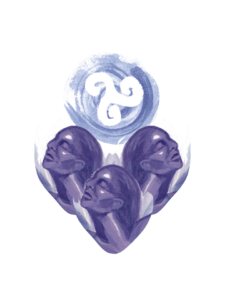 The Tuath De Danann: Now Fairies
The Tuath De Danann: Now Fairies
Any person worth their salt knows that nature is to be respected and feared. No amount of modern knowledge can shake beliefs within people. That stark, inexplicable ‘knowing’ that -out there- in the forests and mountains and glens, the deadliest spooks reside.
Any soul that dares to disturb them will find they are not worth saving. They will surely find that their life will
no longer be about living, but surviving, the cruelest supernatural and spiritual torture imaginable.
Stories still spread today of people going missing, swallowed by mountains, taken by the fairy folk. Of children being taken and replaced with changelings; banshees wailing or announcing the fate of yet another poor local. Fools touching fairy trees, returning home to find they have been plunged a hundred years into the future, their friends and family long since dead…
…and the even more foolish ones, who having cut down fairy trees on their land, are struck by the strangest and most heartbreaking bad luck; finding their crops failing, livestock dying, money stolen, and family affected by the worst plagues known to man.
Whether you believe that the Sons of Mil -in their raging battle with the Tuath De Danann- outsmarted the gods themselves and forced them underground or you think that the Tuath De Danann -unprepared to share the land with anyone- chose to live parallel to these wretched men, rather than amongst them, it is plain from these stories that they still live in Ireland today.
For thousands of years, they have lived in Ireland causing chaos and wreaking havoc when the smallest thing displeases them. Some Christians believe that they are fallen angels, not worthy of saving, nor worthy of hell. Some believe that these old gods -no longer worshipped, praised or offered gifts of any kind- have shrunken with their reputation and become small and notionate (fanciful), ill-tempered tricksters.
Whatever your beliefs, be sure you respect the Fairy Folk. Especially at this time of year. Protect yourself against them; they are the ones who truly own and rule the land.
Background
Nuala Monaghan was selected as the commissioned artist for this exhibition, by Gael Linn, An tUltach and the Liverpool Irish Festival. We are extremely grateful to these partners for their support and to The Reader, for hosting the exhibit. We are extremely proud of Nuala and the dedication, commitment and creativity she has shown in her commitment to the commission.
The storyteller speaks
I grew up with a fascination for the myths and legends of Ireland. When I saw the opportunity to apply for the Liverpool Irish Festival commission, I knew that -whatever I was going to do- it was going to be about the magic of our mystic ancient history.
Working in Navan Fort in Armagh, I know a fair bit about the Ulster Cycle of Tales; the myths and legends of the Cattle Raid of Cooley with Queen Maeve; King Conor MacNessa and Ulster’s champion, Cú Chulainn. I’m fascinated by the Cycle of Invasions; the arrival of the first peoples in Ireland and the old gods, the Tuath De Danann; the People of the Goddess Danu. It made sense to learn about the gods of old in order to understand the ways of life, of ancient people, here.
Like all [my] projects, it started with a brainstorm. I quickly went down the rabbit hole of how the Tuath De Danann are still with us as ‘the fairy folk’. We never let go of our old gods, and most of us don’t realise it. They are visible in our superstitions, and even though the country exchanged Paganism for Christianity, we kept our Pagan tradition of Hallowe’en.
In order to explore the idea of Hallowe’en more, I wanted to highlight the origins. I chose the stories then, about the first people in Ireland, introducing the gods, and revealing their downfall.
I had a go at making my own ink from indigenous plants; experimenting with blackberries, willow, and woad. The results weren’t great, but it was fun; drying and boiling leaves and crushing berries. I was particularly interested in the woad plant, which Celts used to make their blue war paint, but -again- it was not overly successful. It’s unbelievable how intelligent people were thousands of years ago; knowledge we take for granted today.
Imagine having the knowledge you needed in your head, not on a phone or in a book! Imagine the sense of community [within] a people who learn from previous generations and by doing.
This experimentation certainly got me into the headspace for the project. After sketching out thumbnail ideas, and considering the symbolism I wanted to use, I took photos to work from and did more research. The skull is drawn from a photo of one that was found in a ritual pool near the King’s Stables (Armagh). Some of the faces are from sculptures I’d photographed on holidays, or items I’d seen in museums. It makes me think about how all these cultures came to Ireland over thousands of years and eventually developed into its own. I made lots of marks and textures I could collage together, digitally, and stuck with a purple and blue colour palette. This is a land of kings and queens after all; purple for royalty (as well as death) and blue: the colour of war.
Words cannot describe how grateful I am for the opportunity to highlight these aspects of our ancient heritage. We learn from stories and we enrich our lives with art. I have enjoyed every second of this project and learned a lot through it. I hope that sparks something in whoever sees it, too.
The Calder Stones
The Calder Stones are a set of six stones, which are now known to have formed a megalithic (large and prehistoric) tomb, 4,800 years ago.
Since the tomb was first disturbed in circa 1550, the stones have survived several moves and treatments, resulting in their current residence in the Grade II listed Mansion House grounds, where you may see them today.
The Calder Stones were erected in the New Stone Age, or Neolithic, which runs up until circa 2,000BCE. The stones bear many markings including spirals, foot shapes and daggers, linking them to other sites of similar ages, on both sides of the Irish Sea. This suggests the people in Merseyside at this time had cultural, trade and possibly migratory links with the island of Ireland. The Calder Stone’s connection with Ireland’s folklore made this location ideal for this exhibit. The Reader is the official guardian of the stones.
The Reader
The Reader is a national charity that wants to bring about a Reading Revolution, so everyone can experience and enjoy great literature, which they believe is a tool for helping humans survive and live well. Through a growing movement of 1,000 volunteers and partners, The Reader brings thousands of people together, weekly,
to share and discuss great novels, short stories and poems. This is called ‘Shared Reading’. The Reader runs Shared Reading groups with schools, families and looked-after-children; adults in community spaces; people in care homes; people with physical and mental health conditions; those coping with or recovering from addiction and people in the criminal justice system.
Liverpool Irish Festival
The Liverpool Irish Festival (registered charity No.1100126, company No. 4800736) is governed by a volunteer board, chaired by John Chandler, an original founder.
We receive regular funding from Liverpool City Council’s Culture Arts Investment Programme and the Irish Department of Foreign Affairs Emigrant Support Programme. In 2020, we were recipients of HM Government’s Cultural Recovery Funding: #HereForCulture.
We have been fortunate to receive National Lottery Heritage Funding for work on the Liverpool Irish Famine Trail; Arts Council England funding (to deliver art content in Oct 2021) and Tourism Ireland sponsorship.
Gael Linn and An tUltach
Gael Linn is a non-profit and non-governmental organisation focused on the promotion of the Irish language and the arts. An tUltach is Ireland’s oldest Irish language literary magazine, established in 1924.
To each we say thank you and go raibh maith agat/may you have goodness.
